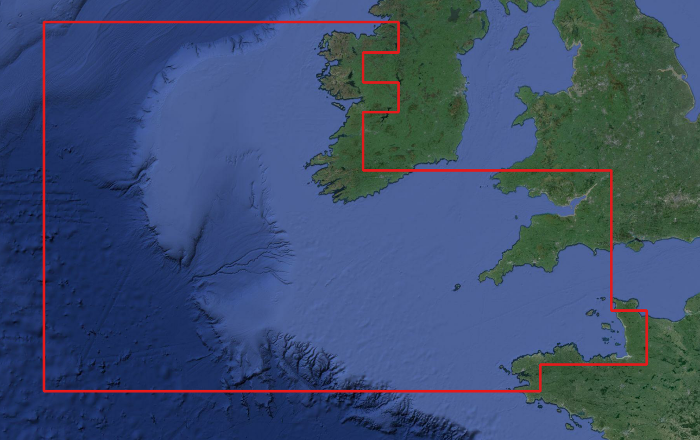Celtic Sea
Abstract: Data used to produce figures come from the STECF working group on Fisheries Dependent Informations . Please not that time series might be incomplete for some countries/indicators.
Landings
The North Western waters include the shelf area west of Scotland (ICES
Division VIa), the Irish Sea (
ICES Division VIIa) and the Celtic Sea
(
ICES Divisions VII b-c and
e-k).
The Celtic Sea is an extended shelf of the Atlantic ocean where most of the area is shallower than 100 m. It is limited to the west by the slope of the Porcupine Seabight and the Goban Spur. Beyond the Porcupine Seabight, to the west of Ireland, the Porcupine Bank forms a large extension of the shelf, which is limited to the west by the Rockall Trough. The Irish Sea, which borders the north east extent of the Celtic Sea, is shallow (less than 100 m deep in most places) and largely sheltered from the winds and currents of the North Atlantic. The English Channel is a shallow (40-100 m) part of the continental shelf.

Sources : Google Satellite Imagery
Thermal stratification and tidal mixing generate the Irish coastal current which runs westwards in the Celtic Sea and northwards along the west coast of Ireland. In the Irish Sea, an inshore coastal current carries water from the Celtic Sea and St. Georges Channel northwards through the North Channel. The main oceanographic front in the NE Atlantic region is the Irish Shelf Front that occurs to the south and west of Ireland, and exists all year-round. This front marks the boundary between waters of the shelf (often mixed vertically by the tide) and offshore North Atlantic waters.
Proportion of landings in each rectangle
The variety of habitats in the Celtic Sea accommodates a diverse range of fish, crustacean and cephalopod species that support a wide variety
of fisheries targeting different species assemblages from pelagic to demersal.
Several important pelagic stocks from the North East Atlantic, including boarfish (Capros aper), blue whiting (Micromesistius poutassou), mackerel (Scomber scombrus) and horse mackerel (Trachurus trachurus), migrate and spawn along the western European slope (Marine Institute, 2015). The unique hydrographic conditions and food supplies in the shelf edge region play an important part in each stage of these species lifecycles and as a result they are of significant commercial importance in this region. Despite pelagic trawling being responsible for more landings than any other gear types, in terms of volume and value, in the Celtic Sea this fishery only accounts for a small fraction of the total fishing effort in this area. Due to the unrepresentative nature of the pelagic fisheries in terms of activity vs landings it is important to consider pelagic and demersal fisheries separately in the Celtic Sea to gain a full understanding of the fisheries that operate in this ecoregion.
Average Landings by gears
Average Landings by countries
The following maps illustrate the spatial distribution of the catches of main targets species and the catches per gear in the Celtic Sea, based on STECF catch data. Each statistical rectangle is split depending on the proportion of each species/gear catches and their size are proportional to the total amount of catches. Discards time series begin in 2012 due to missing data prior to this date.
Average Landings by species
Discards
The Celtic Sea groundfish community consists of over a hundred species and the most abundant 25 comprise 99% of the total estimated biomass and around 93% of total estimated numbers (Trenkel and Rochet, 2003). This ecoregion has important commercial fisheries for cod, haddock, whiting and a number of flatfish species. Hake (Merluccius merluccius) and anglerfish (Lophius spp) are also fished across the whole area. The
shelf slope (500-1800 m) comprises a distinct species assemblage, including roundnose grenadier (Coryphaenoides rupestris), black
scabbardfish (Aphanopus carbo), blue ling (Molva macrophthalma) and orange roughy (Hoplostethus atlanticus), as well as deep-sea squalidae
(sharks) and macrouridae. The major commercial invertebrate species is the Norway lobster (Nephrops norvegicus), targeted by trawl fisheries
throughout the Celtic Sea. Common cuttlefish (Sepia officinalis) are also exploited in the Celtic Sea, whilst there is dredging for scallops and smaller bivalves in the western English Channel, Irish Sea and west of Scotland. Pot fisheries take place for lobster (Homarus gammarus) and
edible crab (Cancer pagurus) in coastal areas of this region. The most commonly used gear types in the Celtic Sea are otter trawls, beam
trawls, netters, dredges and pots.
En savoir plus
Citation :
Fiche Celtic Sea, Author(s) : Marianne Robert, Lionel Pawloswki, David Reid ...
DiscardLess Atlas [on line]. 2017. Guitton J., Ulrich, C., Vermard Y., Afonso P., Andonegi E., Argyrou I., Calderwood J., Fauconnet L., Quetglas A., Morato T., Prellezo R., Robert M., Savina-Rolland M., Triantaphyllidis G., Vaz S.
http://www.discardless.eu/atlas/